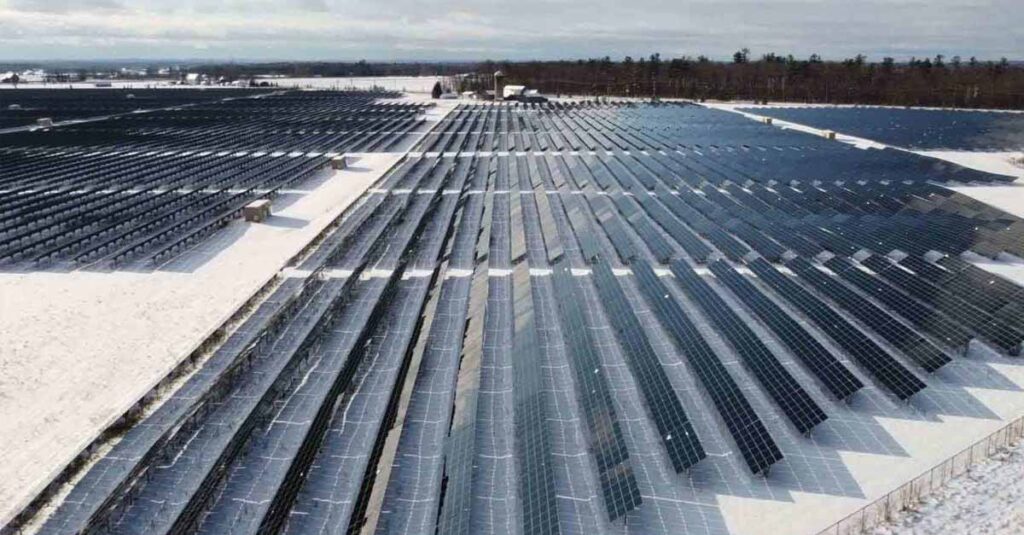Across the country, local innovators are coming up with fresh, practical solutions for how we create, store, and share clean energy. Their work is doing more than cutting emissions; it’s changing how entire industries operate and putting Canada on the map as a leader in clean technology.
The Renewable Revolution Takes Hold
For years, Canada built its economy around its rich natural resources. Now, those same resources are helping fuel a new kind of energy economy, one that’s driven more by innovation than extraction.
“The transition to clean energy represents the greatest economic opportunity of our generation. Canadian companies are at the forefront of this shift, developing technologies that will power our future while creating thousands of good jobs.” says Justin Trudeau, Canada’s Prime Minister.
In 2024 alone, clean tech companies in Canada pulled in over $14.8 billion in investment, with nearly 60% going into renewable energy projects. They’re transformative investments that recognize Canada’s unique position at the crossroads of resource wealth, technological innovation, and environmental stewardship.
Solar Solutions: Canadian Innovation Shining Bright
Canadian Solar, headquartered in Guelph, Ontario, exemplifies the country’s renewable energy leadership. Founded in 2001, the company has evolved from a small manufacturing operation to a global solar powerhouse, delivering nearly 150 GW of premium-quality solar photovoltaic modules to customers worldwide.
What sets Canadian Solar apart isn’t just their scale but their commitment to continuous innovation. In 2024, they unveiled their cutting-edge SolBank 3.0 Plus battery storage solution at Intersolar, showcasing technology that allows flexible energy deployment precisely when and where it’s needed most.
The company recently partnered with Flow Power to implement innovative anti-hail solar panels in South Australia. Technology developed specifically to withstand extreme weather patterns caused by climate change. This practical innovation demonstrates how Canadian companies are addressing real-world challenges while advancing renewable adoption.
Geothermal Breakthrough: Heat Beneath Our Feet
While solar and wind dominate clean energy headlines, Canadian companies are pioneering less visible but equally impactful technologies. Calgary-based Eavor Technologies has developed an approach to geothermal energy that could transform how we harness heat from beneath the Earth’s surface.
Traditional geothermal systems rely on finding naturally occurring hot water reservoirs, a significant limitation that has restricted widespread adoption. Eavor’s closed-loop technology, dubbed the “Eavor-Loop,” eliminates this constraint by creating an underground radiator system that can be deployed virtually anywhere.
The provincial government recently invested $750,000 in a feasibility study led by Eavor to assess viability, site selection, and economic impacts of larger-scale deployments across Canada. If successful, this technology could provide constant, emissions-free power regardless of weather conditions, addressing the intermittency challenges that have limited other renewable sources.
Capturing Carbon: Direct Air Technologies
While transitioning to renewables remains important, addressing existing atmospheric carbon presents an equally urgent challenge. Carbon Engineering, based in Squamish, British Columbia, has pioneered direct air capture (DAC) technology that literally pulls CO₂ from the atmosphere.
Their approach uses a combination of cooling towers and chemical reactions to extract carbon dioxide directly from ambient air. Once captured, this CO₂ can either be permanently stored underground or converted into carbon-neutral fuels—creating a circular carbon economy.
What makes Carbon Engineering’s approach particularly promising is its scalability. Their commercial facilities can potentially remove millions of tons of CO₂ annually—equivalent to the emissions from hundreds of thousands of vehicles.
The company’s innovation has attracted significant investment, including from major energy companies seeking to offset their emissions. In late 2024, construction began on their largest facility yet, which will capture 500,000 tons of carbon dioxide annually, making it one of the world’s largest DAC operations.
Energy Storage: Solving Renewables’ Biggest Challenge
Perhaps the most critical piece of the renewable energy puzzle is storage. How to maintain power supply when the sun isn’t shining or the wind isn’t blowing. Several Canadian companies are delivering breakthrough solutions to this fundamental challenge.
Toronto-based e-Zinc has developed a zinc-based energy storage technology that offers remarkable flexibility and longevity. Unlike conventional lithium-ion batteries, e-Zinc’s system can provide power for days rather than hours, making it ideal for grid-scale applications.
The company’s innovation earned it a place on the prestigious 2025 Global Cleantech 100 list, alongside eight other Canadian firms. With $42 million in new funding secured in 2024, e-Zinc is scaling up for field demonstration projects that could transform how utilities integrate renewable energy.
Similarly, Hydrostor has pioneered Advanced Compressed Air Energy Storage (A-CAES), a technology that uses surplus electricity to compress air, which is stored in underground caverns. When energy is needed, the compressed air is released to generate electricity.
This innovative approach offers 50+ year system lifetimes with minimal environmental impact. In February 2025, Hydrostor secured $200 million in funding from investors, including the Canada Growth Fund, to accelerate deployment of their technology both domestically and internationally.

Hydrogen: Canada’s Next Energy Frontier
Perhaps no clean energy sector shows more promise for Canada than hydrogen. With abundant renewable electricity and natural gas resources, Canada is uniquely positioned to become a global hydrogen superpower.
The federal government’s Hydrogen Strategy outlines a path toward developing a robust hydrogen economy that could create up to 350,000 jobs and reduce annual greenhouse gas emissions by up to 45 million metric tons by 2030.
Approximately 80 low-carbon hydrogen production projects have been announced across Canada, representing over $100 billion in potential investments. Most notably, Air Products is developing a $1.6 billion net-zero hydrogen energy complex in Edmonton, Alberta, which will be one of North America’s largest.
The federal government has reinforced this commitment with significant policy support, including the Clean Hydrogen Investment Tax Credit, which offers up to 40% of eligible capital costs for hydrogen production projects, positioning Canada competitively against similar incentives in the United States and Europe.
Policy Support: Building the Foundation for Growth
Canada’s clean tech revolution isn’t happening by accident. Strategic policy frameworks have created fertile ground for innovation and investment.
The 2024 Federal Budget introduced expanded Investment Tax Credits for clean technology (30%), clean electricity (15%), clean hydrogen (up to 40%), and carbon capture utilization and storage (up to 60%). These incentives have dramatically improved project economics, attracting both domestic and international capital.
Additionally, the $8 billion Net Zero Accelerator initiative provides direct support to large-scale projects that will significantly reduce Canada’s industrial emissions while creating jobs. This combination of tax incentives and direct investment has created powerful momentum across the clean tech space.
The Battery Supply Chain: Mining to Manufacturing
Canadian innovators are also addressing critical mineral challenges in the clean energy supply chain. Vancouver-based Mangrove Lithium recently secured $35 million to construct North America’s first electrochemical lithium refining facility.
This breakthrough technology can process lithium from diverse sources, including hard rock, brine, clay, and recycled materials, reducing dependence on concentrated supply regions and minimizing environmental impact.
This development comes as global demand for battery minerals is projected to increase by over 40 times by 2040, according to the International Energy Agency. By focusing on both extraction and processing, Canadian companies are positioning the country as a reliable supplier of critical minerals needed for the global energy transition.
Challenges and Opportunities Ahead
Despite remarkable progress, challenges remain. Financing early-stage innovations, navigating complex regulatory environments, and scaling production all present hurdles for Canadian clean tech ventures.
Additionally, competition from other jurisdictions, particularly the United States with its massive Inflation Reduction Act incentives, has created pressure to accelerate development timelines and enhance support mechanisms.
Yet Canada’s unique advantages (stable governance, abundant natural resources, advanced research capabilities, and committed public policy) provide strong foundations for continued leadership. The recent addition of several Canadian companies to the Global Cleantech 100 list reinforces the country’s growing international reputation for innovation.
Canada’s Sustainable Future
As global demand for clean energy solutions accelerates, Canadian companies are poised to expand their international impact while delivering domestic environmental and economic benefits.
The next phase of development will likely focus on integration, combining various renewable technologies with storage, smart grid solutions, and hydrogen infrastructure to create resilient, flexible energy systems. Companies that can deliver these integrated solutions will be particularly well-positioned for growth.
For communities across Canada, this clean tech revolution offers tangible benefits: cleaner air, economic diversification, high-quality jobs, and enhanced energy security. The transition also represents an opportunity to address historical inequities by ensuring Indigenous communities and resource-dependent regions share in the benefits of the emerging clean economy.
As Canadian companies continue to push the boundaries of what’s possible in renewable energy, they’re reducing emissions, and building the foundation for a more sustainable, prosperous future.













